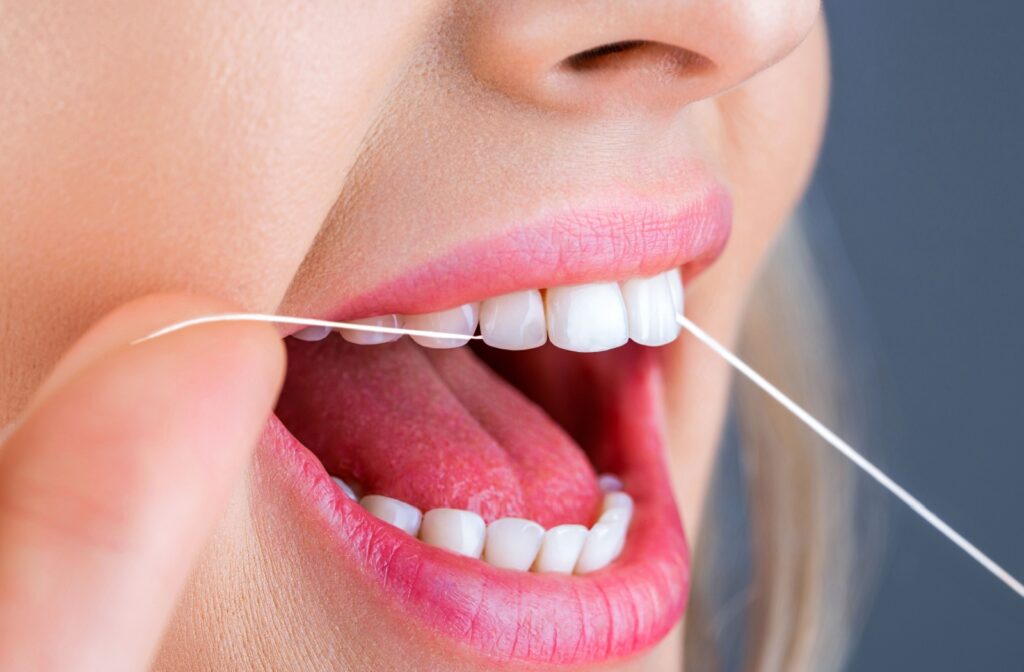If you’ve ever noticed your gums bleeding when you floss, you’re not alone—and it’s not always a cause for alarm. Bleeding gums are often a sign that your oral hygiene routine needs a little more consistency or care. So, why do your teeth bleed when you floss?
Most often, it’s due to plaque buildup near the gumline, which causes inflammation. When you start flossing regularly, the gums may bleed as they adjust—but the bleeding typically stops once your gums become healthier.
Bleeding Gums: What’s Causing It?
If you’re new to flossing or have recently restarted the habit, some bleeding is common. Plaque and food particles often collect between teeth and along the gumline, irritating the gums and making them inflamed.
When you floss, you disturb that buildup, which can trigger bleeding—especially if your gums are already sensitive.
In most cases, this irritation improves within 1–2 weeks with regular flossing. But if the bleeding persists, it could point to other issues such as:
- Gingivitis, the earliest stage of gum disease, causes swelling, tenderness, bleeding, & other progressive complications if left untreated
- Hormonal changes, including pregnancy, menstruation, & menopause, can make your gums more sensitive
- Vitamin deficiencies, such as a lack of vitamin C, D, and certain B vitamins, can impact your gum health & lead to gum disease
- Medications, including certain prescriptions like blood thinners, can make gums more prone to bleeding
If bleeding continues beyond 2 weeks of consistent flossing, you should consult your dentist.
Why Flossing Matters More Than You Think
Brushing alone doesn’t reach the tight spaces between your teeth where food and plaque love to hide. That’s where flossing comes in—it’s essential for:
- Preventing cavities by removing food, debris, & bacteria trapped between teeth
- Avoiding gum disease, which begins with inflammation & can lead to tooth loss
- Fighting bad breath caused by trapped bacteria accumulating between teeth
What’s more, maintaining healthy gums can support your overall health. Gum disease impacts more than your mouth, as it’s linked to systemic conditions like heart disease, diabetes, and even respiratory illness.
By flossing daily, you’re not just protecting your teeth—you’re contributing to long-term wellness.
Alternatives to Traditional Flossing
If using regular dental floss is difficult, uncomfortable, or just not your style, you’re not out of options. Several alternatives can help keep your gums and teeth healthy.
Each tool has its pros and cons, so it may take a bit of trial and error to find what works best for your routine. The key is consistency—whichever method you choose, using it daily will benefit your gum health.
Floss Picks
Floss picks are small plastic tools that hold a short piece of floss, making it easier for some people to maneuver. These tools are particularly helpful for kids and people with limited dexterity.
Water Flossers (Oral Irrigators)
Water flossers are devices that use a pressurized stream of water to remove plaque and debris. They’re especially helpful for people with braces, implants, or sensitive gums.
Interdental Brushes
Interdental brushes are tiny, toothbrush-like tools—like a toothpick with soft bristles—that can help clean larger gaps between teeth and around dental appliances.
Soft Picks or Rubber Tip Stimulators
Soft picks are gentle tools that can help stimulate the gums and remove light debris without harsh pressure.

How to Floss Properly
Improper flossing can cause gum damage or irritation. Follow these simple steps to floss effectively and gently:
- Start with about 18 inches of floss & wrap most of it around your middle fingers, leaving 1–2 inches for maneuvering.
- Slide the floss gently between your teeth. Don’t snap it in—this can cut your gums.
- Curve it around each tooth in a C-shape & glide it up & down to remove debris & plaque.
- Use a clean section of floss for each tooth to prevent the spread of bacteria.
- Don’t forget the molars! The back of your last molars is often missed & can harbour plaque.
Gentle, consistent flossing is far more effective—and less damaging—than forceful or erratic habits.
When to See a Dentist
If you’ve been flossing daily for 2 weeks or more and your gums still bleed, it’s time to see a dentist. Persistent bleeding could indicate:
- Gingivitis or periodontitis
- Improper flossing technique or tool use
- Other underlying conditions
Routine dental checkups every 6 months are crucial for keeping your gums healthy. Dentists can spot early signs of gum disease, remove hardened plaque (tartar), and help you improve your at-home care.
Healthy Gums Need Ongoing Care
While bleeding gums during flossing may seem alarming, they’re often just a sign that your gums need a bit more attention. With consistent oral hygiene, proper flossing technique (or a reliable alternative), and regular dental visits, your gums can become stronger and healthier over time.
At Arch King West Dental, we’re here to help you care for your smile at every stage. Whether it’s been a while since your last checkup or you’re ready to get back on track with your oral hygiene, our friendly team is here to support you.
Book your appointment today and let’s work together to keep your gums healthy and strong.


